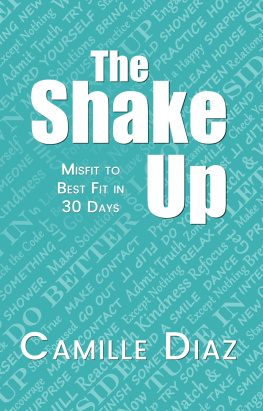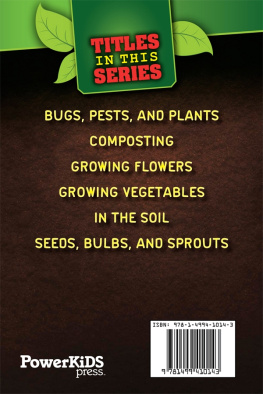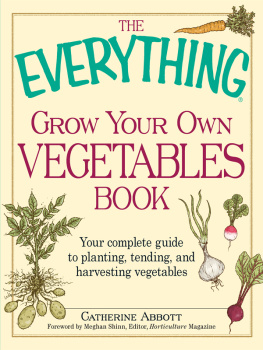The First-Time Growing Vegetables
Everything You Need To Start Growing Your Own Garden
Antonio Diaz
Copyright 2020 Antonio Diaz
All rights reserved.
DEDICATION
The author and publisher have provided this e-book to you for your personal use only. You may not make this e-book publicly available in any way. Copyright infringement is against the law. If you believe the copy of this e-book you are reading infringes on the author's copyright, please notify the publisher at: https://us.macmillan.com/piracy
Contents
How to grow your own veg: a beginners guide
Where do I start?
First, write down which fruit, veg and herbs you love to eat, then cross off those less likely to crop in the UK (bananas and avocados, say). If space is at a premium, dont grow inexpensive staples such as jacket spuds, peas or onions. Instead, go for favourites that dont store well, are hard to come by or are best eaten minutes after harvesting: new potatoes, baby carrots, sweetcorn, pak choi, yellow courgettes, garlic chives and edible flowers.
My annual spring ritual is to surround myself with seed packets of all the veg I want to eat that year. On the back is a sowing guide to the months you can start your crops off (kale in March-May, say, bulb fennel in May-July). Most need just one sowing. Quick-to-mature crops, such as radish, rocket, spinach, salad leaves and baby roots, can be sown in short 1m rows every four to six weeks from March until late August to avoid a glut or dearth.
Which crops do I sow indoors and which outdoors?
Time to maturity is the key factor. Indoor starters include tender veg that take a while to bear a crop (chillies, tomatoes, cape gooseberries, aubergines) and slow-to-bulk-up hardier veg such as celeriac and brussels sprouts. Heated propagators or growlights and mats are great for these early indoor sowings. Quick-to-mature crops such as sweetcorn, squashes, coriander and rocket can be sown outside once the soil warms up in April (start tender ones under tunnel cloches).
What can I do now?
Order your seeds, then get your growing areas ready. Buy compost (a 50:50 mix of multipurpose and John Innes No 3 if your budget allows) for container growing, or dig over veg beds to remove weeds. Early potato varieties (such as Lady Christl) can be planted now, along with onions, shallots, garlic and broad beans, and if you lay cloches over beds or pots to warm them hardy veg such as carrots, beetroot and spinach. Indoors, herbs will set up your kitchen nicely, and microleaves will be ready to cut within two weeks.
Can I buy young plants instead of seeds?
Definitely. In fact, Id recommend it to newcomers, because it bypasses those potentially tricky early stages. Buy plants of fussy germinators such as habanero chillies and flat-leaf parsley. Trays of salad leaves, mangetout peas and broad beans can all be planted directly outside, but these are easy to grow from seed, so do have a go. Grafted veg plants (where crops are grown on super-charged root systems) claim up to 75% higher yields, but cost more. Root congestion can cause premature and reduced cropping, so be fussy when buying cauliflower, broccoli and cabbage plants.
How much of each veg do I sow?
Some (such as cherry tomatoes, salad leaves, climbing beans, courgettes) can produce a huge harvest; others (sweet peppers, asparagus, globe artichokes) give more miserly yields. When sowing outside, make 1-2m rows of lots of different crops (a 1m row of salad leaves, radishes and coriander, say, and a 2m row of dwarf beans, swiss chard and carrots). That way, you avoid gluts and always have a range of crops to harvest. Indoor sowings into pots and trays are more forgiving because gardeners love bartering with surplus plants. Ultimately, aim to end up with small numbers (a dozen runner beans, four tomatoes, two courgettes, three chillies), so youre not overwhelmed.
Any more exciting crops worth a try?
To hold our interest, seed companies continually introduce new crops (purple podded peas and purple carrots are, for example, heritage varieties). Dont pass them off as novelties some are prolific croppers. The oca (a South American potato-equivalent) I grew last year yielded a huge amount of tubers. Cucamelon (a quails egg-sized cucumber relative) will yield generously in a greenhouse. Doughnut-shaped Saturn peaches will reward you, given a sunny wall. Soya beans are worthwhile, as are borlotti beans. The lime green spirals of romanesco cauliflowers and multicoloured Midnight Sun kale are worth growing for appearance alone. Others need a long, hot summer to crop well Ive not been so lucky with sweet potatoes and pomegranates.
What can I grow with a tiny patio and window box?
Why should I grow vegetables from seed?
Growing from seed is the lowest cost and most rewarding method of raising your own plants. Whether you are sowing into seed trays and propagators, or directly into the ground, there is nothing more satisfying than a glorious display of colour and scent, or a bumper crop of tasty fruit and vegetables, that you have grown yourself.
There are two methods to start your seeds growing:
In a greenhouse/conservatory or indoors on the windowsill (usually known as half-hardy seed), then potting on and planting outside at a later stage when the danger of frost has passed. There are lots of easy to use indoor seed propagation products available, such as Suttons Sow & Grow
Directly into the ground where they are intended to grow the quick, easy and very low-cost way to fill your garden with vibrant flowers and tasty vegetables.
You might be surprised to know but you really dont need a big garden to start growing your own vegetables any space will do as long as its a sunny open spot.
If you have a garden or allotment, be it big or small, you can make a dedicated vegetable patch. Alternatively, you can grow within a mixed bed with flowers, in pots on the patio, in outdoor window boxes and even your kitchen windowsill will provide you with a lovely crop of herbs, tomatoes and peppers.
If you are short of space then use large pots and containers. Tomatoes can be grown in hanging baskets, runner beans grown-up wigwams of bamboo canes and even pumpkins and aubergines can now be grown in pots!
Raised beds also provide an attractive and practical alternative to growing in the garden soil due to the fact you can select the positioning, Eg. A sunny spot on the patio. These will also help provide earlier and longer cropping of your veg.












